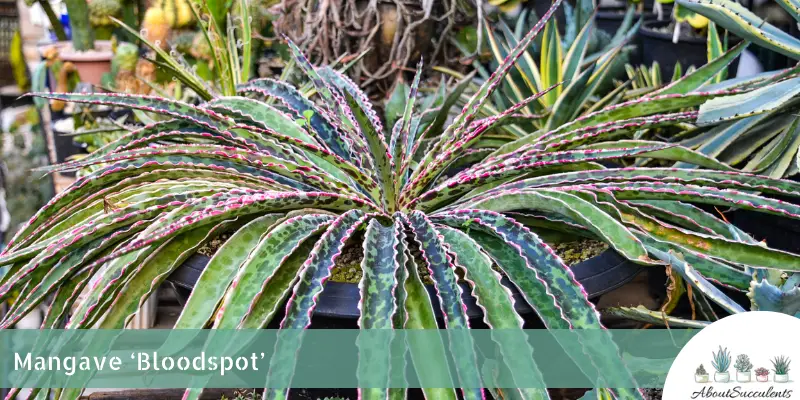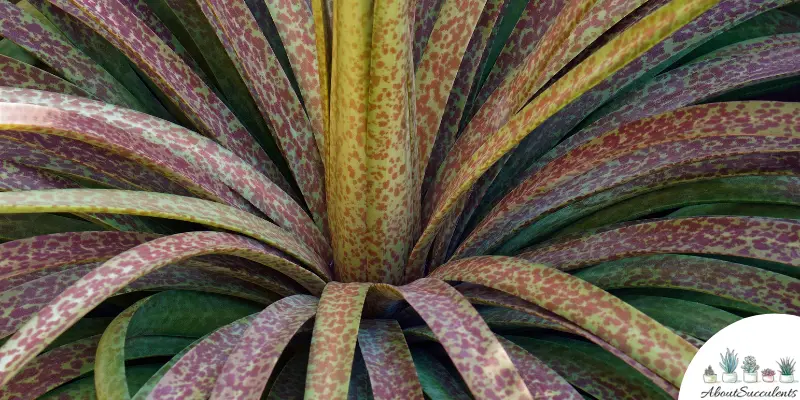
Mangave “Bloodspot” is a succulent that might get described as “weird”, “strange”, or “unusual” but in a complementary and beautiful way. What gives Bloodspot its unique look are the rigid leaves that start out dark green then transition to a greyish-green color and develop red speckles on them.
The edges of the leaves are interesting in themselves. The margins have a maroon color and are accented by what appears to be red teeth. The colors of the leaves are influenced by the growing conditions of Bloodspot.
If grown outdoors, the leaves exhibit a more pronounced hue of colors and more red speckles. However, as the plant gets older, the colors of the leaves are lighter and the speckles will be fewer.
The leaves form a compact rosette that’s symmetrical and resemble those of an Agave. This isn’t surprising as Bloodspot is a hybrid of Agave macroacantha and Manfreda maculosa.
In the summertime, Mangave Bloodspot will bloom small, lime-green flowers. However, Bloodspot is monocarpic and will die after flowering.
Bloodspot is native to Japan and is a member of the Asparagaceae family. The succulent can reach a height of 12-inches (30.5cm) and a width of 24-inches (61cm).
General Information
Also known as: Bloodspot
Plant Family: Asparagaceae
Origin: Japan
Height: 12-inches (30.5cm)
Exposure: Bloodspot prefers full sun but will also thrive in partial shade. Make sure it gets at least 6 hours of partial to full sunlight every day. Avoid the afternoon sun.
Water Needs: Drought-tolerant; test the soil level first before giving it water. If the soil is 100% dry, you can give it a thorough drenching.
Soil Type: Cactus or succulent soil mix with 50% perlite, coarse sand, or pine bark for better drainage.
Soil pH: 6.0 to 7.0
How to Grow and Care for Mangave “Bloodspot”

Mangave Bloodspot is adored by landscape gardeners and hobbyists because it’s a welcome addition to a rock garden, a gravel-type patio, or for motifs that feature Asian, Modern, or Eclectic design elements.
Then there’s the fact the Bloodspot is easy to grow and care for. If you’re the type of person who has a packed schedule on a daily basis, Bloodspot won’t mind if you choose to have a drink of red wine instead of giving its soil a drink of water.
One thing you need to keep in mind is that Mangave Bloodspot isn’t a cold-hardy plant and isn’t durable when exposed to frosty weather.
If your region goes through the winter season or experiences temperature drops below 20° F (-6.7° C), it would be best to grow Bloodspot in a container that can be moved indoors.
Sunlight
Exposure to direct sunlight will bring out the full beauty of Mangave Bloodspot. It will also thrive in partial shade. If you’re getting Bloodspot as an addition to your rock garden, position the succulent in an area where it can be assured of 6 hours of direct or partial sunlight every day.
If you’re willing to spend a bit more time with Bloodspot, you can grow it as a potted outdoor succulent. Expose the plant to direct morning sunlight for 3 to 4 hours before moving it to a partially shaded area.
What you must avoid is exposing Bloodspot directly to the early to mid-afternoon rays of the sun as its leaves will get burned.
As an indoor succulent plant, position Mangave near a window that gets 4 to 6 hours of partial sunlight. You might also want to place Bloodspot under a Grow Light for up to 6 hours.
Your succulent will go through etiolation if it doesn’t get enough sunlight every day. When it etiolates, the plant’s leaves stretch out as if searching for sunlight. The leaves will eventually weaken, wither, and die.
Watering
People love growing and caring for succulents because they don’t have to worry if they forgot to give them water. This is more true when it comes to Mangave Bloodspot which is drought-tolerant and can survive long periods without water.
The biggest mistake first-time succulent growers make is to treat Bloodspot the same as other species of plants and water it frequently. They aren’t aware that they’re slowly killing it.
If the soil stays moist for too long, fungal infections can develop. The roots of the plant will also burst and expose it to fungal infection.
Before watering, insert a stick into the topsoil. If the end of the stick feels dry to the touch, you may give the soil a thorough watering.
During dry months, you might find yourself watering Mangave every seven to 10 days and perhaps only once a month in the winter because soil tends to stay moist for a longer period of time.
Finally, always water from below and never from above. Water the soil and never the plant itself.
Pot and Soil
A pot made of unglazed ceramic or terracotta is the best choice for succulent plants because they allow moisture to escape from the soil faster than any other material.
Choose a pot that’s larger than the base of Bloodspot to enable efficient aeration in the soil and for the roots to grow without getting tangled. The recommended size of the pot for Mangave is 3.5” (8.89cm).
Lastly, the drain hole at the bottom of the pot must be large enough to allow excess water to flow through. Add a mesh net cover to prevent soil from falling out.
Cactus mix and succulent soil are highly recommended for Mangave Bloodspot because these types of soil are well-draining. You can add 50% perlite, coarse sand, and pine bark to further improve drainage.
How to Propagate Mangave Bloodspot
Are you happy with having Mangave Bloodspot in your outdoor garden that you also want it to adorn your home and office? You can do that simply by spending time propagating the species.
The good news is that Mangave Bloodspot grows offsets or pups near its base. You can use these pups to grow yourself little Bloodspots.
Step 1: Gently pull out the offsets.
Step 2: Place the offsets in a dry area and allow them 2 to 4 days to develop hard calluses.
Step 3: Plant the hardened offsets in cactus or a succulent soil mix.
Step 4: Lightly water the soil and position the pot near a window that receives 4 to 6 hours of sunlight every day.
Step 5: Check if the roots have formed. If so, only water the soil when it has gone completely dry.
Frequently Asked Questions
Is Mangave “Bloodspot” Toxic to Cats and Dogs?
Mangave Bloodspot isn’t included in the list of plants that are toxic to cats and dogs that appear on the website of the American Society for the Prevention of Cruelty to Animals (ASPCA).
Why Is My Mangave “Bloodspot” Dying?
While Mangave Bloodspot doesn’t need much attention and fussing over, if you don’t keep track of its conditions, it could die. The most common problems for Bloodspot are Overwatering and Pest Infestation.
Overwatering
If you see the leaves of Bloodspot developing yellow-brown or blackish spots those are signs that infection has set in and is trying to work itself out of your plant.
The fungi were able to compromise the health of your plant because its roots have rotted from overwatering.
Don’t let the infection spread. Get a sharp knife and cut out all of the infected sections. Before re-using the knife, disinfect it with 70% isopropyl alcohol. Then, remove the plant from the pot and cut off all of the infected roots.
The plant undergoes trauma when it’s infected. Before replanting, let it rest and dry out in a clean area.
While Bloodspot is recovering, prepare a new pot with fresh cactus soil. After you’ve replanted Bloodspot, give it a few more days before watering the soil. By delaying the watering schedule, you allow the succulent to adjust to its new environment.
Pest Infestation
Mealybugs and scale insects will squat in the leaves of Mangave and help themselves to its nutritious sap. Once the succulent is drained of its sap, it will weaken and die. These pests also leave substances that can infect Bloodspot.
Spray the plant with neem oil and remove dead leaves that have accumulated at the bottom to keep pests away. If you see cotton-like substances on the leaves, wipe them off with a Q-tip dipped in 70% isopropyl alcohol.
Yes, Mangave Bloodspot produces flowers in the summertime. The flowers have a lime-green color.
Last Updated on June 9, 2022 by Sofia Lara